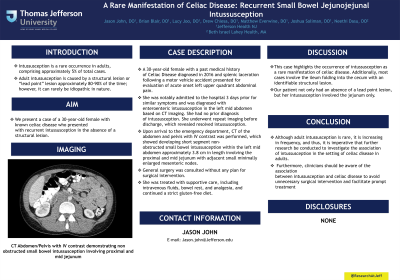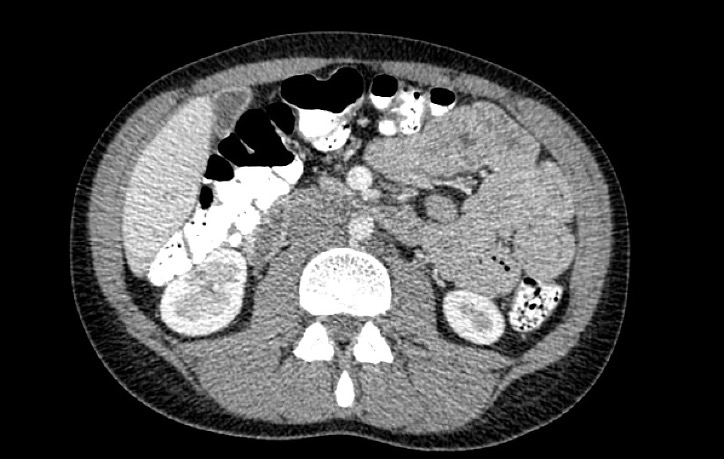Tuesday Poster Session
Category: Small Intestine
P5020 - A Rare Manifestation of Celiac Disease: Recurrent Small Bowel Jejunojejunal Intussusception
Tuesday, October 29, 2024
10:30 AM - 4:00 PM ET
Location: Exhibit Hall E

Has Audio
- JJ
Jason John, DO
Jefferson Health
Pennsauken, NJ
Presenting Author(s)
Jason John, DO1, Brian Blair, DO2, Lucy Joo, DO2, Drew Chiesa, DO3, Matthew Everwine, DO3, Joshua Soliman, DO3, Neethi Dasu, DO4
1Jefferson Health, Pennsauken, NJ; 2Jefferson Health, Cherry Hill, NJ; 3Jefferson Health, Washington Township, NJ; 4Beth Israel Lahey Health, Burlington, MA
Introduction: Intussusception is a rare occurrence in adults, comprising approximately 5% of total cases. Adult intussusception is caused by a structural lesion or “lead point” lesion approximately 80-90% of the time; however, it can rarely be idiopathic in nature. We present a case of a 30-year-old female with known celiac disease who presented with recurrent intussusception in the absence of a structural lesion.
Case Description/Methods: A 30-year-old female with a past medical history of Celiac Disease diagnosed in 2016 and splenic laceration following a motor vehicle accident presented for evaluation of acute onset left upper quadrant abdominal pain. She was notably admitted to the hospital 3 days prior for similar symptoms and was diagnosed with enteroenteric intussusception in the left mid abdomen based on CT imaging. She had no prior diagnosis of intussusception. She underwent repeat imaging before discharge, which revealed resolved intussusception. Upon arrival to the emergency department, CT of the abdomen and pelvis with IV contrast was performed, which showed developing short segment non-obstructed small bowel intussusception within the left mid abdomen approximately 3.8 cm in length involving the proximal and mid jejunum with adjacent small minimally enlarged mesenteric nodes. General surgery was consulted without any plan for surgical intervention. She was treated with supportive care, including intravenous fluids, bowel rest, and analgesia, and continued a strict gluten-free diet.
Discussion: This case highlights the occurrence of intussusception as a rare manifestation of celiac disease. Additionally, most cases involve the ileum folding into the cecum with an identifiable structural lesion. Our patient not only had an absence of a lead point lesion, but her intussusception involved the jejunum only. Although adult intussusception is rare, it is increasing in frequency, and thus, it is imperative that further research be conducted to investigate the association of intussusception in the setting of celiac disease in adults. Furthermore, clinicians should be aware of the association between intussusception and celiac disease to avoid unnecessary surgical intervention and facilitate prompt treatment.

Disclosures:
Jason John, DO1, Brian Blair, DO2, Lucy Joo, DO2, Drew Chiesa, DO3, Matthew Everwine, DO3, Joshua Soliman, DO3, Neethi Dasu, DO4. P5020 - A Rare Manifestation of Celiac Disease: Recurrent Small Bowel Jejunojejunal Intussusception, ACG 2024 Annual Scientific Meeting Abstracts. Philadelphia, PA: American College of Gastroenterology.
1Jefferson Health, Pennsauken, NJ; 2Jefferson Health, Cherry Hill, NJ; 3Jefferson Health, Washington Township, NJ; 4Beth Israel Lahey Health, Burlington, MA
Introduction: Intussusception is a rare occurrence in adults, comprising approximately 5% of total cases. Adult intussusception is caused by a structural lesion or “lead point” lesion approximately 80-90% of the time; however, it can rarely be idiopathic in nature. We present a case of a 30-year-old female with known celiac disease who presented with recurrent intussusception in the absence of a structural lesion.
Case Description/Methods: A 30-year-old female with a past medical history of Celiac Disease diagnosed in 2016 and splenic laceration following a motor vehicle accident presented for evaluation of acute onset left upper quadrant abdominal pain. She was notably admitted to the hospital 3 days prior for similar symptoms and was diagnosed with enteroenteric intussusception in the left mid abdomen based on CT imaging. She had no prior diagnosis of intussusception. She underwent repeat imaging before discharge, which revealed resolved intussusception. Upon arrival to the emergency department, CT of the abdomen and pelvis with IV contrast was performed, which showed developing short segment non-obstructed small bowel intussusception within the left mid abdomen approximately 3.8 cm in length involving the proximal and mid jejunum with adjacent small minimally enlarged mesenteric nodes. General surgery was consulted without any plan for surgical intervention. She was treated with supportive care, including intravenous fluids, bowel rest, and analgesia, and continued a strict gluten-free diet.
Discussion: This case highlights the occurrence of intussusception as a rare manifestation of celiac disease. Additionally, most cases involve the ileum folding into the cecum with an identifiable structural lesion. Our patient not only had an absence of a lead point lesion, but her intussusception involved the jejunum only. Although adult intussusception is rare, it is increasing in frequency, and thus, it is imperative that further research be conducted to investigate the association of intussusception in the setting of celiac disease in adults. Furthermore, clinicians should be aware of the association between intussusception and celiac disease to avoid unnecessary surgical intervention and facilitate prompt treatment.

Figure: CT Abdomen/Pelvis with IV contrast demonstrating non obstructed small bowel intussusception involving proximal and mid jejunum
Disclosures:
Jason John indicated no relevant financial relationships.
Brian Blair indicated no relevant financial relationships.
Lucy Joo indicated no relevant financial relationships.
Drew Chiesa indicated no relevant financial relationships.
Matthew Everwine indicated no relevant financial relationships.
Joshua Soliman indicated no relevant financial relationships.
Neethi Dasu indicated no relevant financial relationships.
Jason John, DO1, Brian Blair, DO2, Lucy Joo, DO2, Drew Chiesa, DO3, Matthew Everwine, DO3, Joshua Soliman, DO3, Neethi Dasu, DO4. P5020 - A Rare Manifestation of Celiac Disease: Recurrent Small Bowel Jejunojejunal Intussusception, ACG 2024 Annual Scientific Meeting Abstracts. Philadelphia, PA: American College of Gastroenterology.
